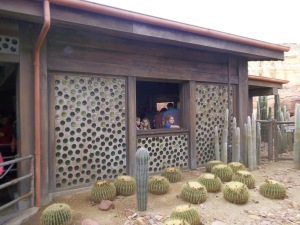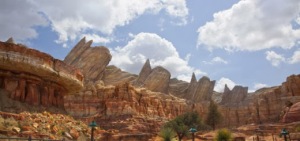The Facebook photos do not lie. I spent a few days on vacation in Disneyland. It was my pal David’s 50th birthday, and he wanted to show his kids the Magic Kingdom. His husband Jay grew up in the San Fernando Valley and fondly remembers visiting on Christmas Day with all the other Jewish families. And I got to go along as the lucky uncle! I could go on about how evil the Disney empire is, but I could also go on about how evil the automobile corporations are, and how evil most banks and mutual funds are, but the truth is that most of us participate, to some degree or another, in these evil empires. A friend of mine wrote to me, “Ask why there are no pigeons or mosquitoes” in Disneyland. That gave me pause. It is important to observe, and maintain a state of critical inquiry, but some questions remain unanswerable.
It was Charles Moore who gave me a new way to look at Disneyland. He wrote about it famously in Perspecta in an essay entitled “You Have to Pay for the Public Life.” That gave the place cred with the intellectual set. But it was his essay in the guidebook Los Angeles: The City Observed that I treasure. He didn’t live long enough to see Disney California Adventure open in 2001, but this newer park has captured some of his love for Los Angeles.
At several levels, Disneyland can be seen as a mirror for the culture. Think about it. It takes an entire subterranean system, endless back lots, and the largest parking garage in the Western hemisphere to make the happiest place on earth function. You don’t see dirty uniforms, nor do you see most of the “cast” that keeps the pedestrian-centric drama going. They are invisible (behind the scenes or in costumes), and so is the ugly car that brought you here. It parallels an idealized life in our own country, but without pigeons and mosquitoes! Easy transit and parking, plentiful clothes, access to nature, controlled density, fresh fruit and veggies year round—all this provided by workers who are largely invisible to us as they toil in the dangerous factories and warehouses of the developing world, the oil tundras of the Middle East, and the fields of God knows where. It takes a huge number of people working in poverty to keep each one of us clothed, housed, fed, and entertained. Disneyland is a microcosm of the global economy that supports our way of life! But without most of the stresses.
What makes Disneyland’s appeal so broad? Why do people keep returning when a one-day ticket to both parks now costs $132? (Never mind the $30 lunches and $300 hotel rooms.) It is because the Disney theme parks are some of the most designed places on earth. Walt Disney believed in the power of design more than any other capitalist I can think of. There have been numerous biographies of Disney, but I am interested in one that focuses on his ideas about aesthetics. What were those conversations about design and narrative like? When Disney built a new studio in 1940 in Burbank, he hired noted modernist designer Kem Weber (whose furniture now fetches high prices at auction and is featured in museum collections) to give it a modern edge, with most workspaces accessible to daylight.
Disney was obsessed with detail and would spend large sums to make his animations better and to innovate. He gambled on new technologies, and often he won. He understood and exploited media synergies to great advantage. When we were kids, we watched Walt Disney’s Wonderful World of Color every Sunday night and hoped to see shots of the park we had just visited. We only went to a handful of films as a family, and, of course, Mary Poppins was one of them. Each kind of product helped built interest in another. What child in the United States doesn’t know Mickey Mouse (who would have been named Mortimer if Lillian Disney hadn’t had some sway)?
But Disneyland can also be painful. For a child, it is a rich experience, one that lasts well into adulthood. Of course, new films appear, the culture changes, and a theme park must evolve, and in terms of a child’s memory, change radically. Each visit is both nostalgic and sad. When I was young, in the mid-1960s, my favorite icon was the Monsanto House of the Future. I wanted to live there! Tomorrowland felt like a real look into the next decade, which I was impatient to reach. By the time the futuristic house was torn down in the late 1960s, tomorrow was yesterday’s news. Even though the monorail cars have gone through several generations of improvement, they look sort of silly now. It’s hard to say if the future ended when man stepped on the moon, but the future is no longer a place, it’s a cloud. And Tomorrowland feels placeless now. There are still submarines, but now they are all about Captain Nemo.… If you don’t keep up with popular culture (brought to you by Disney and Pixar), visiting Disneyland can be a bit like walking through a dream where you don’t know the cues.
One day for lunch we ate “outside” on the terrace at Blue Bayou, where you are part of the entertainment for the Pirates of the Caribbean ride. When I was a kid, passing that romantic café before descending into the watery depths, I wondered where it was located. I probably thought the customers were part of the latest technology, what I later learned was called animatronics. When I was slightly older, I wondered if they were actors. Then I thought perhaps you get a free lunch to perform as happy diners in nighttime New Orleans. In fact, you pay dearly to be part of the show. And this is one the genius concepts of Disneyland. You are a cast member too! When you are too exhausted to go on, finding a bench (outside the restrooms, which are based on Frank Lloyd Wright’s Storer house) and watching this strangely egalitarian parade is almost a fun as looking at the ones that Disney organizes throughout the day. That you can do at no extra charge.
As for the Pirates ride itself, I don’t think it is as much fun since it’s been redesigned around a kohl-eyed Johnny Depp. The same is true for the haunted house, which has been temporarily reconfigured to celebrate Tim Burton’s Christmas. I rather enjoyed Burton’s creepy characters in MoMA’s show a few years ago, but they seem forced in the haunted house. I have to say that the ginger cookie smell that was spritzed at us was especially noxious. But both Johnny Depp and Tim Burton must be a bit surprised that they turned up as features in a Disney theme park. Had Uncle Walt met them on Main Street, he would have had security throw the bums out!
On a trip to California Adventure in 2006, I found the newer park strangely barren, too vast, without the variety of scale and density, mature landscaping, and all-important berms of the original park. Much as the basis for the Disneyland entrance sequence is based on Walt Disney’s own boyhood in Missouri, the new Buena Vista Street and Carthay Circle are based on the Los Angeles that Disney experienced when he arrived and first began working in the city he would end up interpreting for the rest of us. The Imagineers went back to their roots, Walt’s own nostalgia.
Interestingly, one of the most popular rides in the old Disneyland park is Autopia, which trains the wee ones for the autocentric future (architect Charles Moore is especially funny on this point). It is also one of the oldest continuously operating rides. Building on that ongoing success (I love that the ride is in Tomorrowland) and the success of the Cars movies series (what’s better than to turn the devil itself, the automobile, into something loveable?), the Imagineers created an entire themed “land.” Irony builds on irony. You park your car a good 20 minutes from the entry to either Disneyland or California Adventure and then walk 20 minutes to wait between 20 and 90 minutes to ride in a miniature car for four or five minutes. Brilliant! But the waiting at Radiator Springs Racers is almost as good as the ride. Beautiful desert landscaping and even a reproduction of a historic bottle house. Reportedly the ride cost $200 million to build. It’s more tied to the Southwest than to California, but who cares? It’s still about cars and movies.
When you walk through Radiator Springs, past the Flo’s V8 Café with its piston supported canopies and the Cozy Cone Motel based on wigwam motels, you see the glorious peaks of Cadillac Range, a spoof on the avant-garde artist collective Cadillac Ranch. Somehow the Ant Farm’s crazy art project in Amarillo, Texas, has been co-opted for Disneyland. It’s almost as sweet as the hippie geodesic dome, which must house some drug taking commune-ists. (Check out the Jumping Jellyfish for a drug-inspired ride!) Even though the founder of the happiest place on earth might be appalled that the counterculture has influenced his squeaky-clean dream, he would love to hear the cash registers ringing—or pinging.
For more information:
http://www.waltdisney.org/
http://passport2dreams.blogspot.com/2012/11/the-awkward-transitions-of-disneyland.html
http://www.themagazineantiques.com/articles/kem-weber-southern-california/
http://www.planetizen.com/node/49293








